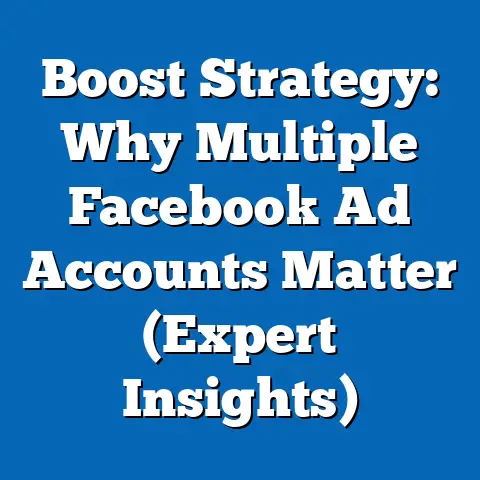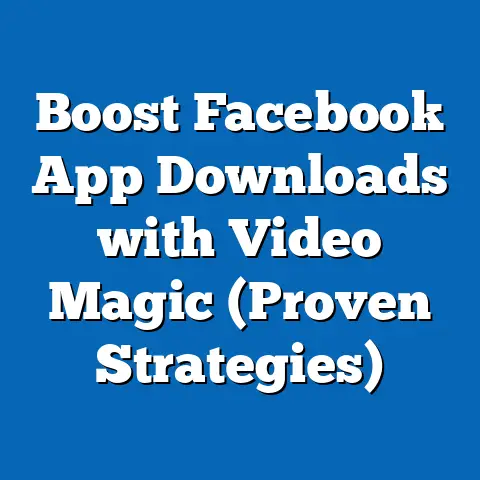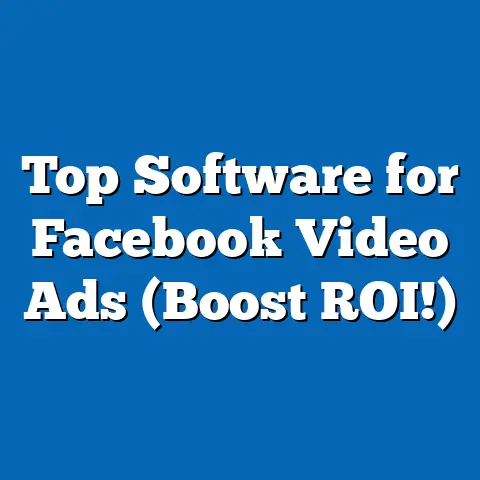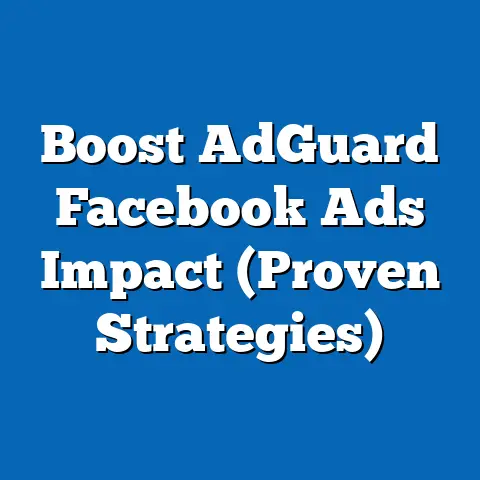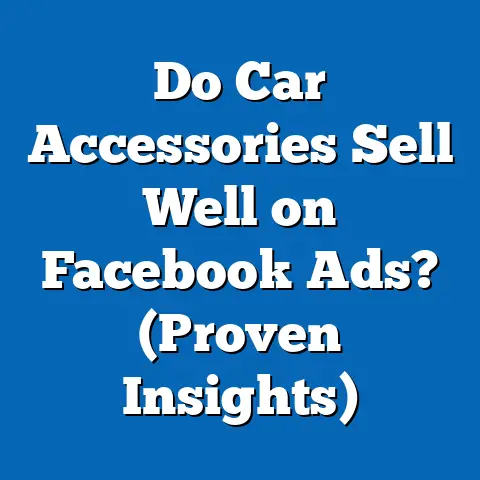Optimize Facebook Postpaid Ad Account (Pro Tips Inside)
Let’s face it, diving into Facebook Ads Manager can feel like navigating a labyrinth. I remember when I first started, I was completely overwhelmed. The sheer number of options, targeting capabilities, and metrics was enough to make my head spin. I’d pump money into campaigns, hoping for the best, only to be met with lackluster engagement and disappointing conversion rates. Sound familiar? You’re not alone. Many advertisers feel lost in the maze of Facebook advertising, struggling to achieve their desired results. That’s why optimizing your Facebook postpaid ad account is crucial. With the right strategies and a clear understanding of how to leverage the platform, you can drastically improve your results, alleviate the frustration, and unlock the true potential of Facebook advertising. This isn’t just about throwing money at ads; it’s about smart, strategic investment.
Understanding the Basics of Facebook Ads
Before we dive into the optimization tactics, let’s make sure we’re all on the same page regarding the fundamental components of Facebook Ads. Think of it as building a house – you need a solid foundation before you can start adding the fancy fixtures.
Ad Formats: Choosing the Right Canvas
Facebook offers a variety of ad formats, each designed to capture attention and drive specific actions. Here’s a quick overview:
-
Image Ads: These are your basic, but still effective, ads featuring a single image or video. They’re great for showcasing products, services, or brand messaging. I’ve found that high-quality, visually appealing images perform best. Avoid stock photos if possible, and opt for authentic visuals that resonate with your target audience.
-
Video Ads: As video continues to dominate the digital landscape, video ads are incredibly powerful. Short, engaging videos that tell a story or demonstrate a product’s value are particularly effective. I always recommend adding captions to your videos, as many users watch with the sound off.
-
Carousel Ads: These ads allow you to showcase multiple images or videos in a single ad unit. They’re perfect for highlighting different features of a product, telling a story, or showcasing a range of products. I’ve seen carousel ads work wonders for e-commerce businesses.
-
Collection Ads: Designed for mobile shoppers, collection ads feature a hero image or video followed by a grid of related products. This format provides a seamless shopping experience directly within Facebook.
-
Instant Experience Ads: These are full-screen, mobile-optimized ads that open when someone clicks on your ad. They offer an immersive and engaging experience, allowing you to showcase your brand or product in a visually rich format.
-
Lead Ads: Specifically designed to collect leads, these ads allow users to submit their contact information directly within Facebook, without having to visit your website. I’ve found lead ads to be incredibly effective for generating leads for services like insurance, real estate, and education.
Image Ads: These are your basic, but still effective, ads featuring a single image or video. They’re great for showcasing products, services, or brand messaging. I’ve found that high-quality, visually appealing images perform best. Avoid stock photos if possible, and opt for authentic visuals that resonate with your target audience.
Video Ads: As video continues to dominate the digital landscape, video ads are incredibly powerful. Short, engaging videos that tell a story or demonstrate a product’s value are particularly effective. I always recommend adding captions to your videos, as many users watch with the sound off.
Carousel Ads: These ads allow you to showcase multiple images or videos in a single ad unit. They’re perfect for highlighting different features of a product, telling a story, or showcasing a range of products. I’ve seen carousel ads work wonders for e-commerce businesses.
Collection Ads: Designed for mobile shoppers, collection ads feature a hero image or video followed by a grid of related products. This format provides a seamless shopping experience directly within Facebook.
Instant Experience Ads: These are full-screen, mobile-optimized ads that open when someone clicks on your ad. They offer an immersive and engaging experience, allowing you to showcase your brand or product in a visually rich format.
Lead Ads: Specifically designed to collect leads, these ads allow users to submit their contact information directly within Facebook, without having to visit your website. I’ve found lead ads to be incredibly effective for generating leads for services like insurance, real estate, and education.
Takeaway: Choosing the right ad format is crucial for capturing attention and driving the desired action. Experiment with different formats to see what resonates best with your target audience.
Placement Options: Where Will Your Ad Live?
Facebook offers a variety of placement options, allowing you to display your ads on Facebook, Instagram, Audience Network, and Messenger. Each placement has its own unique characteristics and audience demographics.
-
Facebook Feed: This is the most common placement, where ads appear directly in users’ news feeds.
-
Instagram Feed: Similar to Facebook Feed, but on Instagram.
-
Facebook Marketplace: Ads appear in the Facebook Marketplace, targeting users who are actively looking to buy products.
-
Facebook Right Column: Ads appear in the right-hand column on Facebook desktop.
-
Instagram Explore: Ads appear in the Instagram Explore section, targeting users who are discovering new content.
-
Messenger Inbox: Ads appear in the Messenger inbox, targeting users who are actively using Messenger.
-
Audience Network: This allows you to extend your reach beyond Facebook and Instagram by displaying your ads on a network of third-party websites and apps.
Facebook Feed: This is the most common placement, where ads appear directly in users’ news feeds.
Instagram Feed: Similar to Facebook Feed, but on Instagram.
Facebook Marketplace: Ads appear in the Facebook Marketplace, targeting users who are actively looking to buy products.
Facebook Right Column: Ads appear in the right-hand column on Facebook desktop.
Instagram Explore: Ads appear in the Instagram Explore section, targeting users who are discovering new content.
Messenger Inbox: Ads appear in the Messenger inbox, targeting users who are actively using Messenger.
Audience Network: This allows you to extend your reach beyond Facebook and Instagram by displaying your ads on a network of third-party websites and apps.
Takeaway: Consider your target audience and campaign objectives when choosing your ad placements. Test different placements to see which ones deliver the best results.
Bidding Strategies: How Much Are You Willing to Pay?
Facebook offers a variety of bidding strategies, allowing you to control how much you’re willing to pay for each ad interaction.
-
Highest Volume: This strategy aims to get you the most results for your budget, but it may not be the most cost-effective.
-
Cost Per Result Goal: This strategy allows you to set a target cost per result, and Facebook will try to achieve that goal.
-
Cost Cap: This strategy allows you to set a maximum amount you’re willing to pay for each result.
-
Bid Cap: This strategy allows you to set a maximum amount you’re willing to bid in the auction.
-
Minimum ROAS: This strategy aims to maximize your return on ad spend (ROAS) by bidding aggressively for high-value conversions. (Requires Conversion API or advanced tracking)
Highest Volume: This strategy aims to get you the most results for your budget, but it may not be the most cost-effective.
Cost Per Result Goal: This strategy allows you to set a target cost per result, and Facebook will try to achieve that goal.
Cost Cap: This strategy allows you to set a maximum amount you’re willing to pay for each result.
Bid Cap: This strategy allows you to set a maximum amount you’re willing to bid in the auction.
Minimum ROAS: This strategy aims to maximize your return on ad spend (ROAS) by bidding aggressively for high-value conversions. (Requires Conversion API or advanced tracking)
Takeaway: Your bidding strategy should align with your campaign objectives and budget. Experiment with different strategies to see which ones deliver the best results. I personally prefer Cost Cap or Cost Per Result Goal in many cases, as they provide more control over spending.
Knowing Your Target Audience: Who Are You Trying to Reach?
Understanding your target audience is paramount to the success of your Facebook ads. You need to know who you’re trying to reach, what their interests are, and what motivates them.
- Demographics: Age, gender, location, education, job title, etc.
- Interests: Hobbies, passions, and things they’re interested in.
- Behaviors: Online activities, purchase history, and device usage.
Takeaway: The more you know about your target audience, the more effective your ads will be. Use Facebook’s targeting options to reach the right people with the right message.
Campaign Objectives: What Do You Want to Achieve?
Facebook offers a variety of campaign objectives, each designed to help you achieve specific goals.
- Awareness: Increase brand awareness and reach a broad audience.
- Consideration: Drive traffic to your website, generate leads, or increase engagement.
- Conversion: Drive sales, generate leads, or encourage app installs.
Takeaway: Choose the campaign objective that aligns with your overall marketing goals.
Setting Up Your Postpaid Ad Account for Success
Now that we’ve covered the basics, let’s talk about setting up your Facebook postpaid ad account for success. This is like laying the groundwork for your entire advertising strategy.
Step-by-Step Guide to Setting Up Your Account
-
Create a Facebook Business Manager Account: If you don’t already have one, create a Facebook Business Manager account. This is where you’ll manage your ad accounts, pages, and team members.
-
Create an Ad Account: Within Business Manager, create an ad account. Make sure to select the correct currency and time zone.
-
Set Up Payment Information: Add your credit card or PayPal account to your ad account.
-
Define Your Business Details: Provide your business name, address, and other relevant information.
-
Set Up Pixel (if applicable): Install the Facebook Pixel on your website to track conversions and retarget website visitors.
-
Define Conversions (if applicable): Set up conversion events in Facebook Events Manager to track specific actions on your website, such as purchases, form submissions, or add-to-carts.
-
Set Up Your Business Settings: Ensure you have verified your business and set up two-factor authentication for added security.
Create a Facebook Business Manager Account: If you don’t already have one, create a Facebook Business Manager account. This is where you’ll manage your ad accounts, pages, and team members.
Create an Ad Account: Within Business Manager, create an ad account. Make sure to select the correct currency and time zone.
Set Up Payment Information: Add your credit card or PayPal account to your ad account.
Define Your Business Details: Provide your business name, address, and other relevant information.
Set Up Pixel (if applicable): Install the Facebook Pixel on your website to track conversions and retarget website visitors.
Define Conversions (if applicable): Set up conversion events in Facebook Events Manager to track specific actions on your website, such as purchases, form submissions, or add-to-carts.
Set Up Your Business Settings: Ensure you have verified your business and set up two-factor authentication for added security.
Takeaway: A well-configured ad account is essential for tracking your performance, managing your budget, and ensuring the security of your account.
Linking a Facebook Business Manager Account
Linking your ad account to a Facebook Business Manager account is crucial for several reasons:
-
Centralized Management: Business Manager provides a centralized platform for managing all of your Facebook assets, including ad accounts, pages, and team members.
-
Team Collaboration: Business Manager allows you to grant different levels of access to team members, ensuring that everyone has the appropriate permissions.
-
Enhanced Security: Business Manager provides enhanced security features, such as two-factor authentication and business verification.
Centralized Management: Business Manager provides a centralized platform for managing all of your Facebook assets, including ad accounts, pages, and team members.
Team Collaboration: Business Manager allows you to grant different levels of access to team members, ensuring that everyone has the appropriate permissions.
Enhanced Security: Business Manager provides enhanced security features, such as two-factor authentication and business verification.
Takeaway: If you’re not already using Business Manager, I highly recommend setting it up. It will make your life much easier.
Advantages of a Dedicated Ad Account
Using a dedicated ad account for your postpaid campaigns offers several advantages:
-
Improved Tracking: A dedicated ad account allows you to track the performance of your postpaid campaigns separately from your other campaigns.
-
Better Budget Management: With a dedicated ad account, you can allocate a specific budget to your postpaid campaigns and track your spending more effectively.
-
Enhanced Reporting: A dedicated ad account provides more detailed reporting on your postpaid campaigns, allowing you to identify areas for improvement.
Improved Tracking: A dedicated ad account allows you to track the performance of your postpaid campaigns separately from your other campaigns.
Better Budget Management: With a dedicated ad account, you can allocate a specific budget to your postpaid campaigns and track your spending more effectively.
Enhanced Reporting: A dedicated ad account provides more detailed reporting on your postpaid campaigns, allowing you to identify areas for improvement.
Takeaway: If you’re running both prepaid and postpaid campaigns, I recommend using separate ad accounts for each.
Advanced Targeting Techniques
Now that we’ve covered the basics of setting up your ad account, let’s dive into some advanced targeting techniques that can help you reach the right people with the right message.
Custom Audiences: Targeting Your Existing Customers
Custom Audiences allow you to target your existing customers based on their email addresses, phone numbers, or website activity. This is an incredibly powerful way to retarget users who have already interacted with your brand.
-
Customer List: Upload a list of your customer email addresses or phone numbers to Facebook.
-
Website Traffic: Target users who have visited your website.
-
App Activity: Target users who have interacted with your app.
-
Engagement: Target users who have engaged with your Facebook page or Instagram profile.
Customer List: Upload a list of your customer email addresses or phone numbers to Facebook.
Website Traffic: Target users who have visited your website.
App Activity: Target users who have interacted with your app.
Engagement: Target users who have engaged with your Facebook page or Instagram profile.
Takeaway: Custom Audiences are a great way to re-engage existing customers and drive repeat purchases.
Lookalike Audiences: Finding New Customers Who Resemble Your Best
Lookalike Audiences allow you to find new customers who share similar characteristics with your existing customers. This is a great way to expand your reach and target users who are likely to be interested in your products or services.
-
Source Audience: Choose a source audience, such as your customer list or website visitors.
-
Audience Size: Select the size of your lookalike audience, ranging from 1% to 10% of the population in your target country. A smaller percentage will result in a more targeted audience, while a larger percentage will result in a broader audience.
Source Audience: Choose a source audience, such as your customer list or website visitors.
Audience Size: Select the size of your lookalike audience, ranging from 1% to 10% of the population in your target country. A smaller percentage will result in a more targeted audience, while a larger percentage will result in a broader audience.
Takeaway: Lookalike Audiences are a great way to find new customers who are likely to be interested in your products or services. I’ve often found that starting with a 1% or 2% lookalike audience yields the best results.
Using Pixel for Retargeting
The Facebook Pixel is a small piece of code that you install on your website. It allows you to track the actions that users take on your website, such as visiting specific pages, adding items to their cart, or making a purchase. This information can then be used to retarget users who have interacted with your website.
-
Website Visitors: Target users who have visited your website.
-
Specific Page Visitors: Target users who have visited specific pages on your website, such as product pages or landing pages.
-
Add to Cart: Target users who have added items to their cart but haven’t completed the purchase.
-
Purchase: Target users who have made a purchase on your website.
Website Visitors: Target users who have visited your website.
Specific Page Visitors: Target users who have visited specific pages on your website, such as product pages or landing pages.
Add to Cart: Target users who have added items to their cart but haven’t completed the purchase.
Purchase: Target users who have made a purchase on your website.
Takeaway: Retargeting with the Facebook Pixel is a highly effective way to drive conversions.
Audience Insights: Refining Your Targeting
Facebook Audience Insights provides valuable data about your target audience, including their demographics, interests, and behaviors. This information can be used to refine your targeting and create more effective ads.
-
Demographics: Age, gender, location, education, job title, etc.
-
Interests: Hobbies, passions, and things they’re interested in.
-
Behaviors: Online activities, purchase history, and device usage.
-
Page Likes: The pages that your target audience likes on Facebook.
Demographics: Age, gender, location, education, job title, etc.
Interests: Hobbies, passions, and things they’re interested in.
Behaviors: Online activities, purchase history, and device usage.
Page Likes: The pages that your target audience likes on Facebook.
Takeaway: Use Audience Insights to gain a deeper understanding of your target audience and refine your targeting accordingly. I’ve discovered hidden interests and behaviors using this tool that have significantly improved my ad performance.
A/B Testing Your Audience Segments
A/B testing involves creating two or more versions of your ad and showing them to different audience segments. This allows you to identify which audience segments are most responsive to your ads.
-
Create Multiple Ad Sets: Create multiple ad sets, each targeting a different audience segment.
-
Run Your Ads: Run your ads for a specific period of time, such as a week or two.
-
Analyze the Results: Analyze the results to see which audience segment performed best.
Create Multiple Ad Sets: Create multiple ad sets, each targeting a different audience segment.
Run Your Ads: Run your ads for a specific period of time, such as a week or two.
Analyze the Results: Analyze the results to see which audience segment performed best.
Takeaway: A/B testing is essential for optimizing your targeting and identifying the most responsive audience segments.
Crafting Compelling Ad Creatives
Now that you’ve mastered the art of targeting, let’s talk about crafting compelling ad creatives that will capture attention and drive engagement. This is where your creativity comes into play.
Eye-Catching Visuals
Your ad visuals are the first thing that users will see, so it’s important to make them eye-catching and relevant to your target audience.
-
High-Quality Images: Use high-quality images that are visually appealing and relevant to your brand.
-
Engaging Videos: Create short, engaging videos that tell a story or demonstrate a product’s value.
-
Brand Consistency: Ensure that your visuals are consistent with your brand’s style and aesthetic.
High-Quality Images: Use high-quality images that are visually appealing and relevant to your brand.
Engaging Videos: Create short, engaging videos that tell a story or demonstrate a product’s value.
Brand Consistency: Ensure that your visuals are consistent with your brand’s style and aesthetic.
Takeaway: Invest in high-quality visuals that will capture attention and make your ads stand out. I’ve found that using professional-quality photos and videos can significantly improve ad performance.
Engaging Ad Copy
Your ad copy should be clear, concise, and engaging. It should highlight the benefits of your product or service and encourage users to take action.
-
Clear and Concise: Use clear and concise language that is easy to understand.
-
Highlight Benefits: Focus on the benefits of your product or service, rather than just the features.
-
Use a Strong Call to Action: Tell users what you want them to do, such as “Shop Now,” “Learn More,” or “Sign Up.”
Clear and Concise: Use clear and concise language that is easy to understand.
Highlight Benefits: Focus on the benefits of your product or service, rather than just the features.
Use a Strong Call to Action: Tell users what you want them to do, such as “Shop Now,” “Learn More,” or “Sign Up.”
Takeaway: Write compelling ad copy that will resonate with your target audience and encourage them to take action.
The Power of Video Ads and Carousel Formats
Video ads and carousel formats are incredibly effective for driving engagement and conversions.
-
Video Ads: Short, engaging videos that tell a story or demonstrate a product’s value are particularly effective.
-
Carousel Ads: These ads allow you to showcase multiple images or videos in a single ad unit.
Video Ads: Short, engaging videos that tell a story or demonstrate a product’s value are particularly effective.
Carousel Ads: These ads allow you to showcase multiple images or videos in a single ad unit.
Takeaway: Experiment with video ads and carousel formats to see which ones perform best for your business.
Clear Call-to-Action (CTA)
A clear call-to-action (CTA) is essential for telling users what you want them to do.
-
Shop Now: Encourage users to visit your website and make a purchase.
-
Learn More: Encourage users to visit your website and learn more about your product or service.
-
Sign Up: Encourage users to sign up for your email list or create an account.
-
Contact Us: Encourage users to contact you with questions or inquiries.
Shop Now: Encourage users to visit your website and make a purchase.
Learn More: Encourage users to visit your website and learn more about your product or service.
Sign Up: Encourage users to sign up for your email list or create an account.
Contact Us: Encourage users to contact you with questions or inquiries.
Takeaway: Use a clear and compelling CTA that will encourage users to take the desired action.
Testing Different CTAs
A/B testing different CTAs is a great way to identify which ones are most effective.
-
Create Multiple Ads: Create multiple ads, each with a different CTA.
-
Run Your Ads: Run your ads for a specific period of time, such as a week or two.
-
Analyze the Results: Analyze the results to see which CTA performed best.
Create Multiple Ads: Create multiple ads, each with a different CTA.
Run Your Ads: Run your ads for a specific period of time, such as a week or two.
Analyze the Results: Analyze the results to see which CTA performed best.
Takeaway: A/B testing your CTAs is essential for optimizing your ad performance.
Monitoring and Analyzing Ad Performance
Now that you’re running your ads, it’s important to monitor and analyze their performance to see what’s working and what’s not.
Key Performance Metrics to Monitor
Here are some key performance metrics that you should monitor:
-
Impressions: The number of times your ad was displayed.
-
Reach: The number of unique users who saw your ad.
-
Click-Through Rate (CTR): The percentage of users who clicked on your ad after seeing it.
-
Cost Per Click (CPC): The average cost you paid for each click on your ad.
-
Conversions: The number of desired actions that users took after clicking on your ad, such as making a purchase or signing up for your email list.
-
Cost Per Conversion (CPC): The average cost you paid for each conversion.
-
Return on Ad Spend (ROAS): The amount of revenue you generated for every dollar you spent on advertising.
Impressions: The number of times your ad was displayed.
Reach: The number of unique users who saw your ad.
Click-Through Rate (CTR): The percentage of users who clicked on your ad after seeing it.
Cost Per Click (CPC): The average cost you paid for each click on your ad.
Conversions: The number of desired actions that users took after clicking on your ad, such as making a purchase or signing up for your email list.
Cost Per Conversion (CPC): The average cost you paid for each conversion.
Return on Ad Spend (ROAS): The amount of revenue you generated for every dollar you spent on advertising.
Takeaway: Monitor these key performance metrics to track the success of your ads and identify areas for improvement.
Setting Up Conversion Tracking
Setting up conversion tracking is essential for measuring the effectiveness of your ads.
-
Facebook Pixel: Install the Facebook Pixel on your website to track conversions.
-
Conversion Events: Set up conversion events in Facebook Events Manager to track specific actions on your website.
Facebook Pixel: Install the Facebook Pixel on your website to track conversions.
Conversion Events: Set up conversion events in Facebook Events Manager to track specific actions on your website.
Takeaway: Set up conversion tracking to accurately measure the success of your ads.
Using Facebook Analytics
Facebook Analytics provides valuable insights into your audience’s behavior on your website and app.
-
Demographics: Age, gender, location, etc.
-
Interests: Hobbies, passions, and things they’re interested in.
-
Behaviors: Online activities, purchase history, and device usage.
-
Website Activity: The pages that your audience visits on your website.
-
App Activity: The actions that your audience takes within your app.
Demographics: Age, gender, location, etc.
Interests: Hobbies, passions, and things they’re interested in.
Behaviors: Online activities, purchase history, and device usage.
Website Activity: The pages that your audience visits on your website.
App Activity: The actions that your audience takes within your app.
Takeaway: Use Facebook Analytics to gain a deeper understanding of your audience’s behavior and optimize your ads accordingly.
Interpreting Data and Making Informed Decisions
Interpreting data and making informed decisions is crucial for optimizing your ad performance.
-
Identify Trends: Look for trends in your data to see what’s working and what’s not.
-
Make Adjustments: Based on your findings, make adjustments to your targeting, ad creatives, or bidding strategy.
Identify Trends: Look for trends in your data to see what’s working and what’s not.
Make Adjustments: Based on your findings, make adjustments to your targeting, ad creatives, or bidding strategy.
Takeaway: Continuously analyze your data and make informed decisions to optimize your ad performance.
Budget Management and Bidding Strategies
Now that you’re monitoring and analyzing your ad performance, let’s talk about budget management and bidding strategies.
Budgeting Options
Facebook offers a variety of budgeting options:
-
Daily Budget: The average amount you’re willing to spend each day.
-
Lifetime Budget: The total amount you’re willing to spend over the lifetime of your campaign.
Daily Budget: The average amount you’re willing to spend each day.
Lifetime Budget: The total amount you’re willing to spend over the lifetime of your campaign.
Takeaway: Choose the budgeting option that best suits your needs and campaign objectives.
Bidding Strategies
Facebook offers a variety of bidding strategies:
-
Highest Volume: This strategy aims to get you the most results for your budget, but it may not be the most cost-effective.
-
Cost Per Result Goal: This strategy allows you to set a target cost per result, and Facebook will try to achieve that goal.
-
Cost Cap: This strategy allows you to set a maximum amount you’re willing to pay for each result.
-
Bid Cap: This strategy allows you to set a maximum amount you’re willing to bid in the auction.
-
Minimum ROAS: This strategy aims to maximize your return on ad spend (ROAS) by bidding aggressively for high-value conversions. (Requires Conversion API or advanced tracking)
Highest Volume: This strategy aims to get you the most results for your budget, but it may not be the most cost-effective.
Cost Per Result Goal: This strategy allows you to set a target cost per result, and Facebook will try to achieve that goal.
Cost Cap: This strategy allows you to set a maximum amount you’re willing to pay for each result.
Bid Cap: This strategy allows you to set a maximum amount you’re willing to bid in the auction.
Minimum ROAS: This strategy aims to maximize your return on ad spend (ROAS) by bidding aggressively for high-value conversions. (Requires Conversion API or advanced tracking)
Takeaway: Your bidding strategy should align with your campaign objectives and budget.
Adjusting Budgets Based on Performance
Adjusting your budgets based on performance is crucial for optimizing your ad spend.
-
Increase Budgets: Increase your budgets for campaigns that are performing well.
-
Decrease Budgets: Decrease your budgets for campaigns that are not performing well.
Increase Budgets: Increase your budgets for campaigns that are performing well.
Decrease Budgets: Decrease your budgets for campaigns that are not performing well.
Takeaway: Continuously monitor your ad performance and adjust your budgets accordingly.
Seasonal Trends
Consider seasonal trends when managing your budgets.
-
Increase Budgets During Peak Seasons: Increase your budgets during peak seasons, such as holidays or special events.
-
Decrease Budgets During Off-Peak Seasons: Decrease your budgets during off-peak seasons.
Increase Budgets During Peak Seasons: Increase your budgets during peak seasons, such as holidays or special events.
Decrease Budgets During Off-Peak Seasons: Decrease your budgets during off-peak seasons.
Takeaway: Take seasonal trends into account when managing your budgets.
Continuous Optimization and Scaling
Finally, let’s talk about continuous optimization and scaling your successful campaigns.
Pausing Underperforming Ads
Pausing underperforming ads is essential for optimizing your ad spend.
-
Identify Underperforming Ads: Identify ads that are not performing well, based on your key performance metrics.
-
Pause Those Ads: Pause those ads to avoid wasting your budget.
Identify Underperforming Ads: Identify ads that are not performing well, based on your key performance metrics.
Pause Those Ads: Pause those ads to avoid wasting your budget.
Takeaway: Regularly review your ad performance and pause underperforming ads.
Allocating Budget to Top Performers
Allocate more budget to your top-performing ads.
-
Identify Top Performers: Identify ads that are performing well, based on your key performance metrics.
-
Increase Budgets: Increase the budgets for those ads to maximize their reach and conversions.
Identify Top Performers: Identify ads that are performing well, based on your key performance metrics.
Increase Budgets: Increase the budgets for those ads to maximize their reach and conversions.
Takeaway: Allocate more budget to your top-performing ads to maximize your results.
Refreshing Ad Creatives
Regularly review and refresh your ad creatives to avoid ad fatigue.
-
Create New Visuals: Create new visuals that are fresh and engaging.
-
Write New Ad Copy: Write new ad copy that is clear, concise, and compelling.
Create New Visuals: Create new visuals that are fresh and engaging.
Write New Ad Copy: Write new ad copy that is clear, concise, and compelling.
Takeaway: Regularly refresh your ad creatives to keep your ads engaging and effective.
When and How to Scale
Scaling your successful campaigns can significantly increase your reach and conversions.
-
Increase Budgets: Increase your budgets gradually to avoid disrupting your ad performance.
-
Expand Your Targeting: Expand your targeting to reach a broader audience.
-
Create New Campaigns: Create new campaigns to target different segments of your audience.
Increase Budgets: Increase your budgets gradually to avoid disrupting your ad performance.
Expand Your Targeting: Expand your targeting to reach a broader audience.
Create New Campaigns: Create new campaigns to target different segments of your audience.
Takeaway: Scale your successful campaigns gradually and strategically to maximize your results.
Conclusion
Optimizing your Facebook postpaid ad account is a continuous process that requires ongoing monitoring, analysis, and adjustments. By implementing the pro tips shared throughout this article, you can overcome the challenges of Facebook advertising and achieve better results. Remember, it’s not just about throwing money at ads; it’s about smart, strategic investment. Start applying these strategies in your campaigns and remain adaptable as the platform evolves. Facebook advertising is constantly changing, so it’s important to stay up-to-date with the latest trends and best practices. Good luck, and happy advertising! I’ve seen firsthand the transformative power of a well-optimized Facebook ad account, and I’m confident you can achieve similar results.

